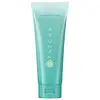What's inside
What's inside
 Key Ingredients
Key Ingredients

 Benefits
Benefits

 Concerns
Concerns

 Ingredients Side-by-side
Ingredients Side-by-side

Water
Skin ConditioningSodium Cocoyl Glutamate
CleansingPropanediol
SolventGlycerin
HumectantAcrylates Copolymer
Coco-Betaine
CleansingCamellia Sinensis Leaf
PerfumingLuffa Cylindrica Fruit/Leaf/Stem Extract
Skin ConditioningLuffa Cylindrica Fruit
AbrasiveSodium Lauroyl Hydrolyzed Silk
Skin ConditioningRosa Multiflora Fruit Extract
MaskingBelamcanda Chinensis Root Extract
Skin ConditioningPotassium Hydroxide
BufferingSodium Chloride
MaskingPolyglyceryl-10 Dioleate
EmulsifyingPolyglyceryl-2 Sesquicaprylate
EmulsifyingButylene Glycol
HumectantEthylhexylglycerin
Skin ConditioningTetrasodium EDTA
Parfum
MaskingAlcohol
AntimicrobialPhenoxyethanol
PreservativeWater, Sodium Cocoyl Glutamate, Propanediol, Glycerin, Acrylates Copolymer, Coco-Betaine, Camellia Sinensis Leaf, Luffa Cylindrica Fruit/Leaf/Stem Extract, Luffa Cylindrica Fruit, Sodium Lauroyl Hydrolyzed Silk, Rosa Multiflora Fruit Extract, Belamcanda Chinensis Root Extract, Potassium Hydroxide, Sodium Chloride, Polyglyceryl-10 Dioleate, Polyglyceryl-2 Sesquicaprylate, Butylene Glycol, Ethylhexylglycerin, Tetrasodium EDTA, Parfum, Alcohol, Phenoxyethanol
Water
Skin ConditioningPalmitic Acid
EmollientStearic Acid
CleansingGlycerin
HumectantMyristic Acid
CleansingLauric Acid
CleansingPotassium Hydroxide
BufferingCocamidopropyl Betaine
CleansingSorbitan Olivate
EmulsifyingCocamide Mipa
EmulsifyingRosa Damascena Flower Water
MaskingLavandula Angustifolia Flower Extract
CleansingSalvia Sclarea Extract
AntiseborrhoeicHyacinthus Orientalis Extract
Skin ConditioningChamomilla Recutita Flower/Leaf Extract
AntimicrobialBorago Officinalis Extract
EmollientCentaurea Cyanus Flower Extract
AstringentHydroxyacetophenone
AntioxidantPEG-14m
Emulsion StabilisingDisodium EDTA
Methylparaben
PreservativePropylparaben
PreservativeParfum
MaskingWater, Palmitic Acid, Stearic Acid, Glycerin, Myristic Acid, Lauric Acid, Potassium Hydroxide, Cocamidopropyl Betaine, Sorbitan Olivate, Cocamide Mipa, Rosa Damascena Flower Water, Lavandula Angustifolia Flower Extract, Salvia Sclarea Extract, Hyacinthus Orientalis Extract, Chamomilla Recutita Flower/Leaf Extract, Borago Officinalis Extract, Centaurea Cyanus Flower Extract, Hydroxyacetophenone, PEG-14m, Disodium EDTA, Methylparaben, Propylparaben, Parfum
 Reviews
Reviews

Ingredients Explained
These ingredients are found in both products.
Ingredients higher up in an ingredient list are typically present in a larger amount.
Glycerin is already naturally found in your skin. It helps moisturize and protect your skin.
A study from 2016 found glycerin to be more effective as a humectant than AHAs and hyaluronic acid.
As a humectant, it helps the skin stay hydrated by pulling moisture to your skin. The low molecular weight of glycerin allows it to pull moisture into the deeper layers of your skin.
Hydrated skin improves your skin barrier; Your skin barrier helps protect against irritants and bacteria.
Glycerin has also been found to have antimicrobial and antiviral properties. Due to these properties, glycerin is often used in wound and burn treatments.
In cosmetics, glycerin is usually derived from plants such as soybean or palm. However, it can also be sourced from animals, such as tallow or animal fat.
This ingredient is organic, colorless, odorless, and non-toxic.
Glycerin is the name for this ingredient in American English. British English uses Glycerol/Glycerine.
Learn more about GlycerinParfum is a catch-all term for an ingredient or more that is used to give a scent to products.
Also called "fragrance", this ingredient can be a blend of hundreds of chemicals or plant oils. This means every product with "fragrance" or "parfum" in the ingredients list is a different mixture.
For instance, Habanolide is a proprietary trade name for a specific aroma chemical. When used as a fragrance ingredient in cosmetics, most aroma chemicals fall under the broad labeling category of “FRAGRANCE” or “PARFUM” according to EU and US regulations.
The term 'parfum' or 'fragrance' is not regulated in many countries. In many cases, it is up to the brand to define this term.
For instance, many brands choose to label themselves as "fragrance-free" because they are not using synthetic fragrances. However, their products may still contain ingredients such as essential oils that are considered a fragrance by INCI standards.
One example is Calendula flower extract. Calendula is an essential oil that still imparts a scent or 'fragrance'.
Depending on the blend, the ingredients in the mixture can cause allergies and sensitivities on the skin. Some ingredients that are known EU allergens include linalool and citronellol.
Parfum can also be used to mask or cover an unpleasant scent.
The bottom line is: not all fragrances/parfum/ingredients are created equally. If you are worried about fragrances, we recommend taking a closer look at an ingredient. And of course, we always recommend speaking with a professional.
Learn more about ParfumPotassium hydroxide is commonly known as caustic potash. It is used to fix the pH of a product or as a cleaning agent in soap. In cleansers, it is used for the saponification of oils.
Sapnification is the process of creating fatty acid metal salts from triglycerides and a strong base. During this process, Potassium Hydroxide is used up and is not present in the final product.
Using high concentrations of Potassium Hydroxide have shown to irritate the skin.
Learn more about Potassium HydroxideWater. It's the most common cosmetic ingredient of all. You'll usually see it at the top of ingredient lists, meaning that it makes up the largest part of the product.
So why is it so popular? Water most often acts as a solvent - this means that it helps dissolve other ingredients into the formulation.
You'll also recognize water as that liquid we all need to stay alive. If you see this, drink a glass of water. Stay hydrated!
Learn more about Water